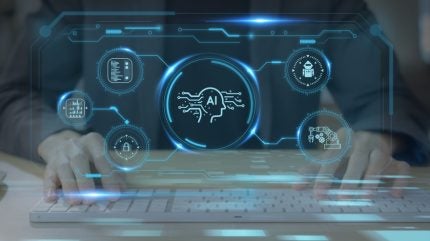
As technology evolves, the integration of AI into industrial processes is expected to grow. Today, some of its key applications include manufacturing, the energy sector, construction, and telecommunications, where AI is used to automate processes, optimise supply chains, manage resources, enable predictive maintenance, and streamline project management, among other crucial functions.
Driving these developments and enabling new efficiencies are several technologies, each playing a critical role in powering the next generation of Industrial AI. Here we examine five of the key developments shaping its future.

Discover B2B Marketing That Performs
Combine business intelligence and editorial excellence to reach engaged professionals across 36 leading media platforms.
1. Natural Language Processing (NLP)
A branch of AI that enables computers to understand, create, and manipulate human language, the integration of NLP into industrial processes is revolutionising operational efficiency. Today, NLP occupies a critical role in numerous industrial processes, including human/machine communication and collaboration, predictive maintenance, and decision-making by providing actionable insights derived from historical data.
Paving the way in Industrial AI NLP is Huawei. With its recent release of Pangu Models 5.5, which boasts a comprehensive upgrade of its NLP, Computer Vision, Multimodal, Prediction, and Scientific Computing Models, Huawei is revolutionising Industrial AI applications.
Pangu NLP is a new deep-thinking model with 718 billion parameters based on Mixture of Experts (MoE) technology. It takes advantage of DeepDiver, which provides advanced search capabilities, to support enterprises in solving complex problems requiring information collection from multiple dimensions and rounds of analysis and integration. This means the model can provide professional instructions, rather than simple conversations, and provides AI technical support for multiple scenarios, such as customer services, creative marketing, and knowledge retrieval.
2. Multimodal Models
Multimodal AI processes, integrates and analyses images, sounds, and text simultaneously to perform tasks that single-modality AI cannot achieve to deliver a more comprehensive understanding of data. It is emerging as a favoured tool for the information-rich industrial sector, where assessment and decision-making require a broad variety of signals, often rendering a single language model insufficient.
Responding to this growing need, Huawei Cloud has recently released the Pangu World Model, which can construct digital spaces for training intelligent driving systems and embodied AI robots, as well as support continuous optimisation and iterations. With new technologies like 4D interaction space, the Pangu World Model is the industry’s first AI model that supports the simultaneous generation of point clouds and videos.
In the field of simulation, Guangzhou Automobile Group (GAC) and Huawei have carried out in-depth cooperation. Relying on the Pangu multimodal large modal, complex scenario corner cases can be reproduced within minutes, supporting two-day iteration.
3. Computer Vision (CV)
Positioned at the forefront of manufacturing’s technological transformation, computer vision uses image analysis and visual data to streamline operations across various applications for improved quality control, predictive maintenance, and safety.
Huawei’s upgraded Pangu CV model is a game-changer for industrial sectors, enabling high-reliability perception and intelligent decision-making, and helping to address challenges in industrial scenarios such as oil and gas, transportation, coal mining, and electric power.
Based on a Mixture of Experts (MoE) architecture, this new model features up to 30 billion parameters, making it the largest CV model in the industry to date. It also supports perception, analysis, and decision-making in complex scenarios such as general and infrared images, laser point clouds, and light spectrum.
4. Predictive Models
Analysing patterns in historical data to connect those patterns with outcomes, predictive models use AI to predict future outcomes from new data. In industrial settings, this can translate to a reduction in machinery downtime and the extension of equipment life, thanks to sensors that track and analyse performance metrics to detect subtle changes that indicate potential failures.
By analysing production data to uncover inefficiencies and optimise workflows, predictive models can also offer intelligent solutions to overcoming manufacturing complexities such as bottlenecks. Utilising AI, they can forecast potential slowdowns by examining machine performance, staffing levels, and material availability, among other factors.
Huawei’s upgraded Pangu Prediction Model offers more accurate predictions and better adaptation to a wider range of industries and scenarios, such as process indicators, sales, and finance. Using the industry’s first triplet transformer architecture for unified pre-training, the model can efficiently encode, process, and pre-train data from different industries within the same framework.
5. Scientific Computing Model
Huawei Cloud has also been continuously deepening its Pangu Scientific Computing Model, applying it across a wider range of scientific application fields. The Meteorological Bureau of Shenzhen Municipality, for example, recently upgraded its Zhiji Model based on Pangu to implement regional ensemble forecasts. Such forecast results can more closely reflect changes in weather systems and help the Bureau to forecast weather more accurately.
Similarly, the Chongqing Meteorological Service built its Tianzi 12-hour Weather Forecast Model based on Pangu to enhance the capabilities of daily forecasting and warning against extreme weather, which is common in the region. Shenzhen Energy Group, meanwhile, is using Pangu to predict short- and mid-term wind and solar energy yields, helping it to adjust power generation more agilely to improve energy development efficiency.
Leaders in the AI evolution
Officially initiated in 2020, Huawei Cloud has continuously evolved and upgraded its Pangu Model over the last five years. Focusing on industry-facing applications, Huawei’s full upgraded 5.5 models help customers tackle the most challenging issues in their sectors while reimagining operations and efficiencies. This sustained evolution has earned Huawei a strong reputation in the AI field.
According to Frost & Sullivan’s Chinese Industry Model Market Report 2024, its Pangu models ranked highest in the government, industry, and finance sectors by market share, and placed it in the Leader quadrant for the healthcare, pharmaceutical, meteorology, and automotive sectors. Subsequently, Pangu Models have been applied in more than 500 scenarios across over 30 industries in the past year.
To find out more about how Pangu can help solve your industry’s key challenges, visit https://www.huaweicloud.com/intl/en-us/

